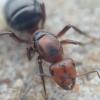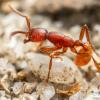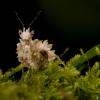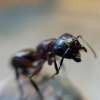Quote form antwiki: "Almost all species of Proceratium spend their lives in concealment, usually in rotten wood or deep humus, but sometimes under stones in colder climates. Captive colonies will accept, usually reluctantly, various types of insect prey, but the principle diet appears to be the eggs of arthropods, particularly spiders (Brown 1958a and 1980). The peculiarly modified gaster seems to be primarily defensive in function. The hypertrophied second gastral tergite conceals the terminal gastral segments, it presents a hardened surface to enemies approaching from the rear, and it is equipped with a gland that probably produces defensive chemicals (Baroni Urbani and de Andrade 2003). Although unusual in ants, insects in other groups have convergently evolved similar adaptations to provide a rigid armor for the gaster, while maintaining flexibility for the terminal abdominal segments... The anteriorly-directed terminal segments of the gaster have also been seen helping in the manipulation and transportation of spider eggs (Brown 1980), but nobody claims that the abdominal modifications are a necessary adaptation for this purpose, as other groups of ants have no difficulty dealing with round objects."
Quote from antwiki:" A small colony (8 specimens) was found in a rotten pine stump below the surface of the ground. Paul Skelley collected several specimens from traps set up in burrow systems of pocket gophers (Geomys pinetis). Wesson and Wesson offered living and dead insects to a captive colony, but the only food accepted were the contents of the gasters of a few dead ants. Brown (1980) found a colony feeding on and storing spider eggs in a nest in rotten wood.
Wesson & Wesson (1940) kept under observation a colony of P. pergandei from Jackson (Ohio) comprising 1 gyne, 11 workers and 8 males. After many attempts to feed the colony on different types of insect food, the authors suggest that these ants may live on dead or dying ants at least in part. Talbot (1957) found in St. Charles (Missouri) a supposedly complete colony of Proceratium pergandei comprising 1 gyne, 13 workers and 13 larvae. (Baroni Urbani and de Andrade 2003)"
So they do seem to enjoy other ants.
Here's some info for replicating nests.
Quote from antweb:"Found most commonly in these habitats: 2 times found in deciduous forest, 2 times found in litter- bamboo thicket in bottomland hardwood forest, 1 times found in mesic campground, 1 times found in mesic forest, 1 times found in mixed flatwoods, 1 times found in base of Pinus sp., 1 times found in mixed pine/hardwood forest, 1 times found in Black Belt Prairie, 1 times found in oak maple woodland, 1 times found in Sand Pine Scrub, ...
Found most commonly in these microhabitats: 1 times log-leaf litter, 1 times litter foragers, 1 times litter.
Collected most commonly using these methods: 2 times Berlese, 4 times Berlese funnel, 3 times malaise trap, 2 times general collecting, 1 times Winkler, 1 times hand collected, 1 times Lindgren funnel trap baited with typosan and alpha-pinene, 1 times malaise trap in mature sand, 1 times pitfall, 0 times pitfall traps."
Edited by ponerinecat, August 18 2019 - 1:34 PM.





















